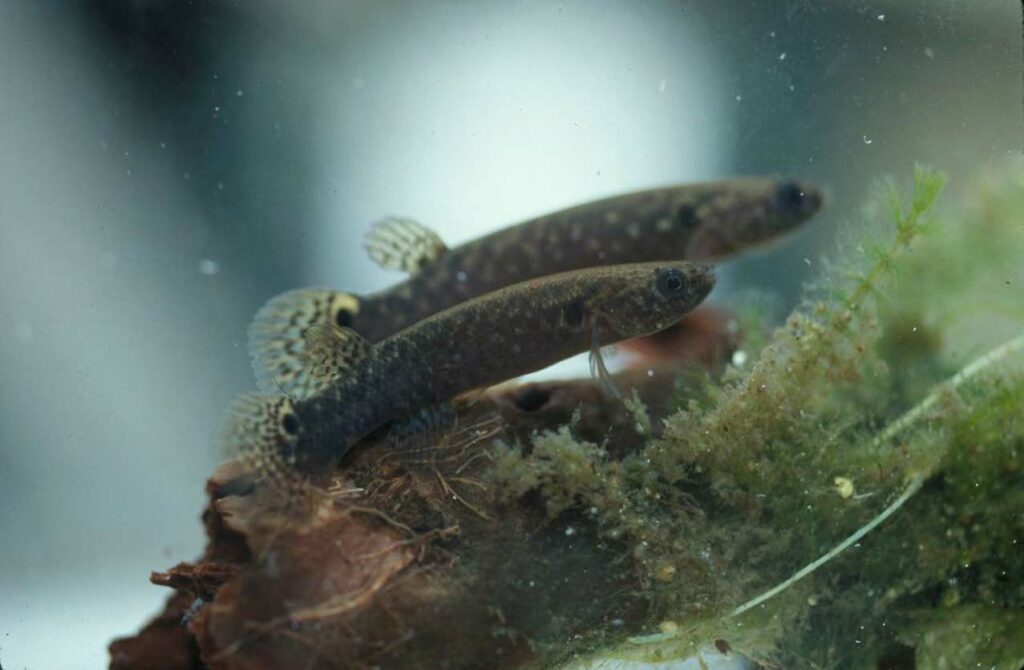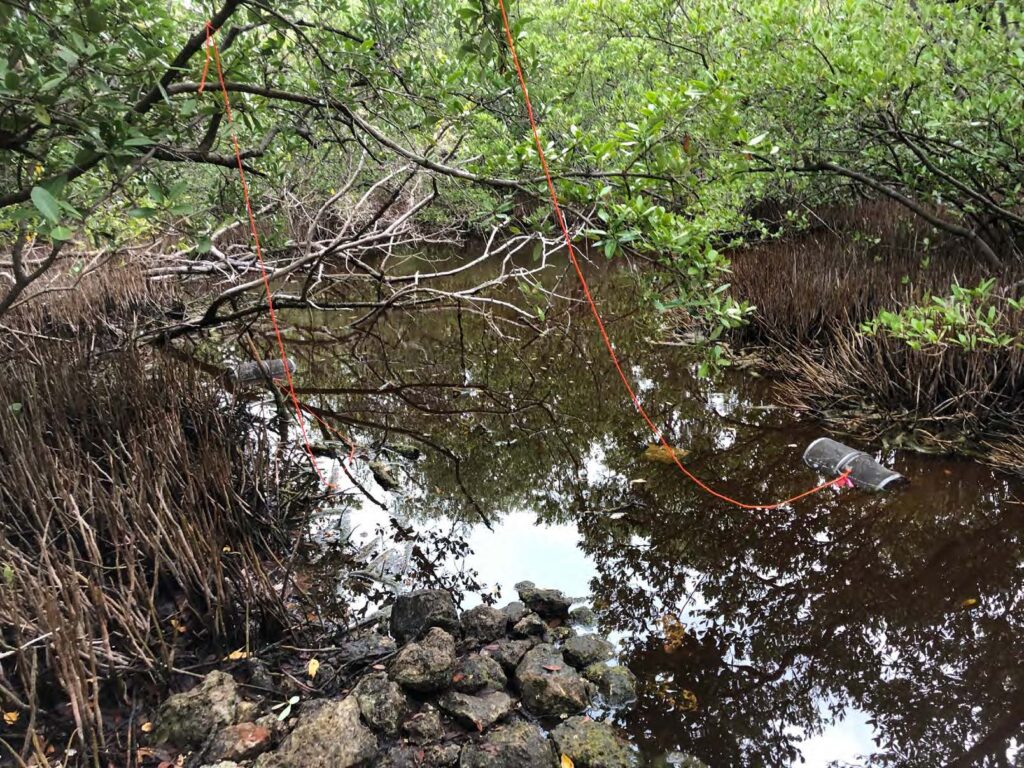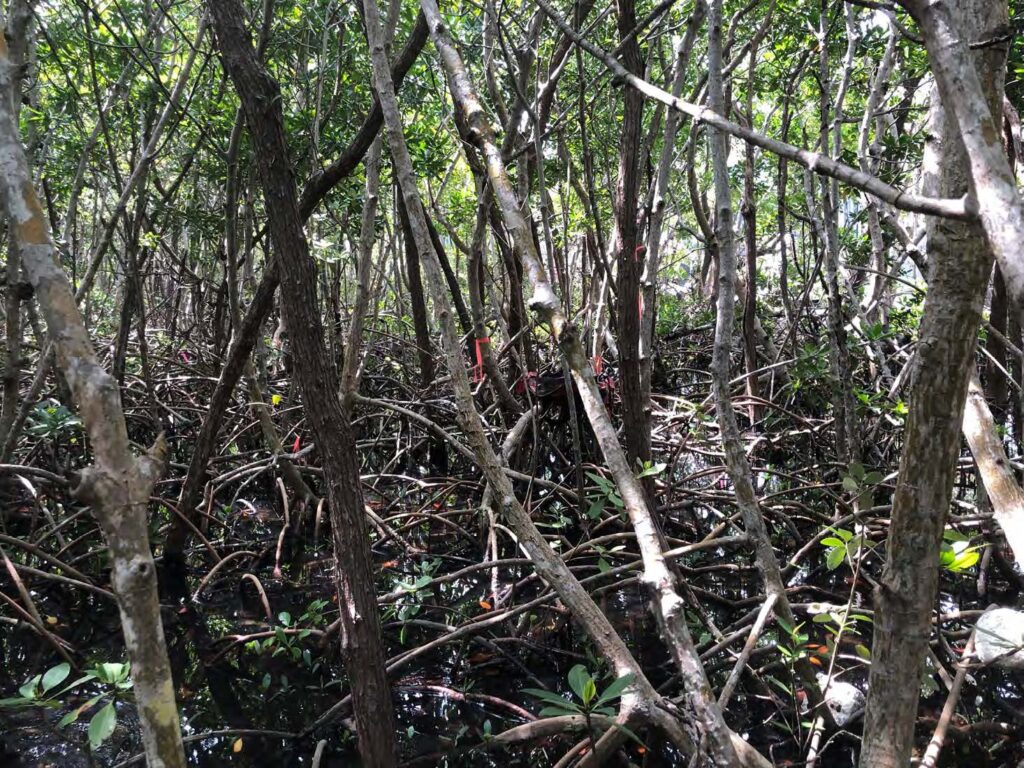Written by Heidi Schmelzer
The mangrove rivulus fish is native to mangrove forests in Florida, the Caribbean, and Central America. Most individuals in this species are self-fertilizing hermaphrodites, allowing them to reproduce on their own. Because of this quality, and their tolerance to a wide range of environmental conditions, rivulus is an important species in researching genetics, ecology, and evolution. One question that studying rivulus helps answer is how species adjust in harshly changing environmental conditions. Mangrove forests in which this fish lives are located in saltwater or brackish water in coastal intertidal zones. The forests experience changing tide levels as well as have general susceptibility to changing environmental conditions such as salinity, temperature, and precipitation.
Mangrove forests are heavily impacted by climate change and are a major focus for conservation efforts. As the rivulus is mostly composed of hermaphrodites and after many generation of self-fertilization, offspring are nearly genetically identical to their parents. This fish makes the perfect system to study how changing environmental conditions in mangrove forests affect individual traits within species that live in this habitat. Anthony Snead, a Ph.D. candidate at the University of Alabama studies the mangrove rivulus fish in the Early Lab in the Biological Sciences Department. He uses rivulus to study both basic research in microevolution and apply it to broader conservation strategies in the face of climate change.

Q & A: Anthony Snead
Please tell us about your PhD studies at the Earley Lab at the University of Alabama and how you came to enter into this program?
Life in science and academia is a combination of luck, timing, and hard work. Unknowingly, my undergraduate research at Saint Leo University (SLU) and the University of South Florida (USF) made me uniquely qualified for the Earley Lab. In 2012, I began volunteering with an Australian-based organization called Mangrove Watch to map the health of mangrove forests across Tampa Bay, FL. I immediately fell in love with research and mangrove forests. Shortly after, I worked with Dr. William Ellis to identify the environmental drivers of tumor-like growths known as galls on red mangroves. Galls serve as weak points that increase mangrove death during extreme weather events. At USF, I worked with Dr. Thomas Crisman, a well-respected and accomplished wetland ecologist, to quantify the impacts of urban landscapes on invertebrate and fish communities in local ponds.
Through my projects with Mangrove Watch, Dr. Ellis, and Dr. Crisman, I gained experience within mangrove forests and fish, making me exceptionally suited to collaborate with Dr. Ryan Earley on the mangrove rivulus fish. I have been with the Earley lab for almost four years, and I am now in the final stages of my doctoral degree. While working on my doctorate, I have expanded the previous research program with a new direction dedicated to combining basic and applied research. My basic research focuses on quantifying environmental drivers of microevolution and fish community structure. In contrast, my applied research aims to predict the future of rivulus under climate change to guide effective conservation strategies.
Why does your lab particularly focus on the Rivulus fish inhabiting the mangroves of Central America, the Caribbean, and Florida?
The mangrove rivulus is a unique system that enables my lab to diversify our research. Hermaphrodites and few males dominate populations. The hermaphrodites generally self-fertilize and form lineages of nearly genetically identical individuals. We use these lineages to isolate the genetic and environmental contributions to an individual’s traits.
Rivulus are also extremophiles capable of tolerating a wide range of salinities, oxygen concentrations, and hydrogen sulfide. The fish can even live outside of water for up to 66 days and move across the land! This unique constellation of traits enables my lab to investigate diverse questions from behavioral evolution to the potential for personalized medicine and everything in between.
I work with rivulus because the habitat they occupy is complex. Mangroves are impacted by climatic factors (e.g., temperature, rainfall) and marine variables (e.g., salinity). To add further complexity, the tides and landscape properties like elevation mediate the impact of these environmental conditions. The habitat changes rapidly across short distances and time, making it the perfect system to explore the effect of temporally variable environmental factors. I focus on rivulus because the small killifish is tolerant of these environmental shifts. I want to know how rivulus survive in this harsh environment and the genes that confer this resilience. If the habitat gets too stressful, the fish irreversible change sex, even though males do not often get the chance to reproduce. Hence, we wonder, why do males even exist in this species? These factors make rivulus ideal to study microevolution and climate change.

As mentioned in your recent publication in Ecological Informatics, what is the effect of climate change on mangrove dependent species?
Mangroves are considered foundation species. Foundation species are groups of or individual species essential for their habitat. Foundation species are often primary producers like trees, but they do more than provide food. They are ecosystem engineers, provide structure, and are critical to maintaining habitat integrity. Therefore, conservation managers often design plans to protect the foundation species in hopes of saving the entire community. However, each species, including foundation species, have unique combinations of environmental conditions in which they thrive.
Climate change has and will continue to change these conditions impacting where species can live. Hence, climate change will disintegrate biological communities because species-specific responses drive distributional changes.
Mangrove forests are projected to expand their range northward under climate change. In my recent publication in Ecological Informatics, I first developed a model to quantify the impact of both climatic and marine variables on rivulus habitat suitability to evaluate if rivulus would respond similarly to mangrove forests. I found that rivulus will not follow mangroves. In fact, rivulus may lose suitable habitat and become more restricted, even though the species is highly tolerant of environmental conditions.
I demonstrate that umbrella protection for mangrove trees will not necessarily protect their community members. Therefore, managers should consider all the target species when designing conservation plans. Additionally, I project future habitat suitability under different climate change scenarios to 2050. I show that the rate of climate change is essential even over short timescales, meaning that time is of the essence for climate change action.

Why is it important to do further research on mangrove habitats and biodiversity as the world faces ongoing climate change?
Biodiversity is often considered important for its intrinsic value; species have an inherent right to exist. However, biodiversity also supports all life on earth, including humans. Agriculture depends on pollinators like birds, bees, butterflies, and other insects, but agriculture also depends on microbes and invertebrates in the soil to recycle nutrients. While plants provide oxygen, many plants also prevent flooding. Many of our medicines are produced or originate from bacteria, fungi, or plants. As human-induced climate change progresses, we need to continue studying biodiversity to know how to protect it.
Mangrove habitats are especially important for both humans and wildlife communities. Mangroves protect coastal communities from storms surge, while the complex root system limits erosion. Mangroves also store carbon and other nutrients from human activities like agriculture, limiting their release into our oceans. Mangroves serve as nursery habitats for estuarine and marine fishes. In Florida, mangroves provide critical habitat for about 90% of the commercially important fish. Even though mangroves are essential, urbanization is decreasing mangrove area globally, with an estimated 33% already lost due to human activity. Even the mangroves that remain are threatened by coastal squeeze.
Coastal squeeze occurs when the sea level rises and forces coastal habitat to migrate upland, but barriers like urbanization limit migration, resulting in habitat loss. By studying these habitats, we can better understand their utility and role within the ecosystem to further protect them and design conservation strategies for mitigating their loss.
Final thoughts
We have learned about the importance of mangrove forests both for the ecosystem and human society. By studying the mangrove rivulus fish, we can learn how species adjust to changing environments and use this information to guide conservation efforts. While current efforts are aimed at preserving the general habitat, Anthony has discovered that this strategy does not always protect individual species within the habitat.
To preserve biodiversity both for its intrinsic value and for the value it brings humans, such as protection from flooding and medicinal properties, we need to study the species at risk due to climate change and apply conservation efforts both individually and to the whole habitat.
Bio
Anthony Snead is a Ph.D. candidate at the University of Alabama in the Biological Sciences Department, applying integrative, interdisciplinary methods to understand the impact of environmental and biotic variables on a mangrove obligate, the mangrove rivulus fish. His work includes both applied projects focused on conservation and basic research in evolutionary biology. He is particularly interested in quantifying microevolution to better predict the future of species under climate change.
Links
Link: anthony-snead.com
